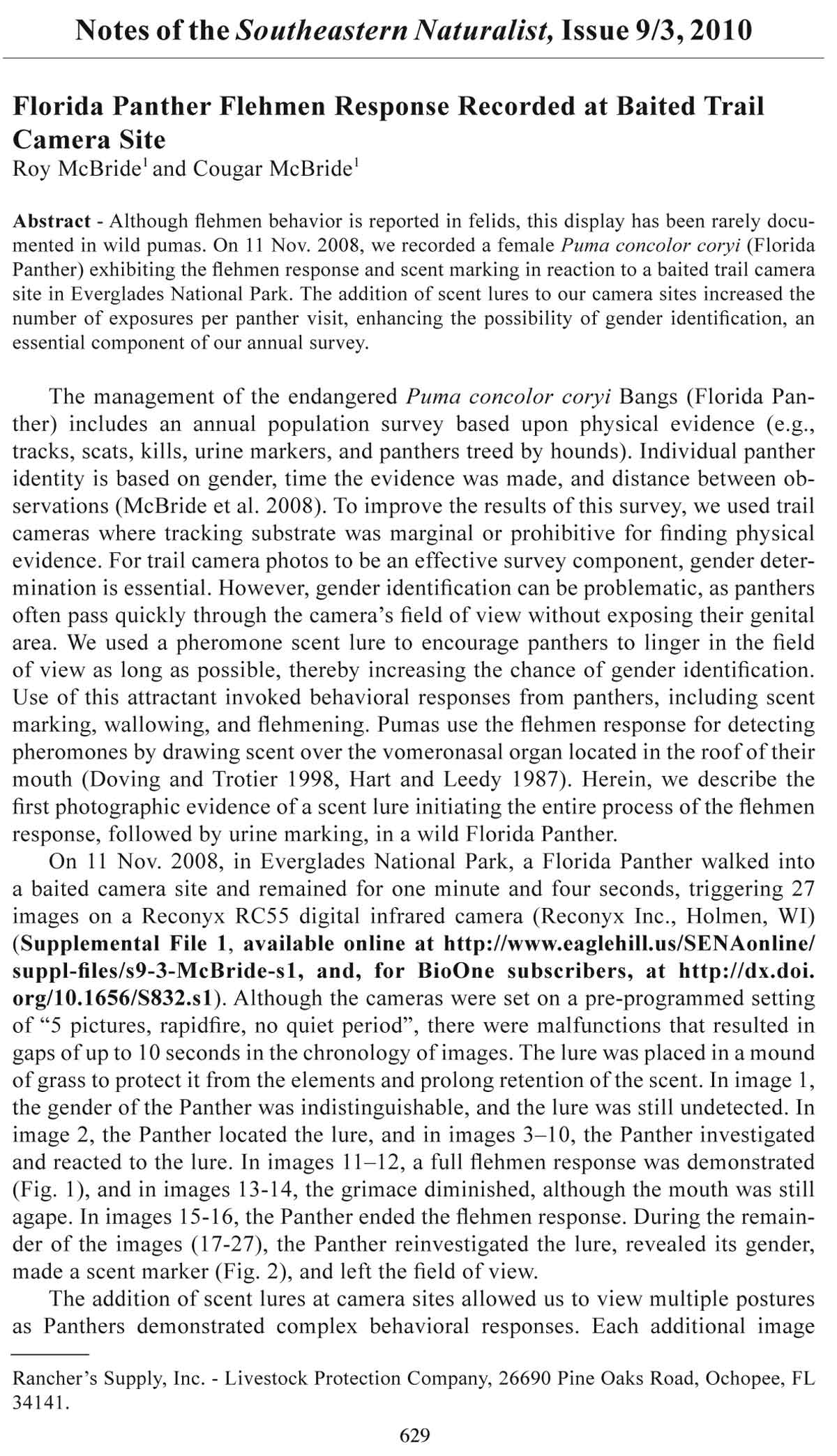Florida Panther Flehmen Response Recorded at Baited Trail
Camera Site
Roy McBride1 and Cougar McBride1
Abstract - Although flehmen behavior is reported in felids, this display has been rarely documented
in wild pumas. On 11 Nov. 2008, we recorded a female Puma concolor coryi (Florida
Panther) exhibiting the flehmen response and scent marking in reaction to a baited trail camera
site in Everglades National Park. The addition of scent lures to our camera sites increased the
number of exposures per panther visit, enhancing the possibility of gender identification, an
essential component of our annual survey.
The management of the endangered Puma concolor coryi Bangs (Florida Panther)
includes an annual population survey based upon physical evidence (e.g.,
tracks, scats, kills, urine markers, and panthers treed by hounds). Individual panther
identity is based on gender, time the evidence was made, and distance between observations
(McBride et al. 2008). To improve the results of this survey, we used trail
cameras where tracking substrate was marginal or prohibitive for finding physical
evidence. For trail camera photos to be an effective survey component, gender determination
is essential. However, gender identification can be problematic, as panthers
often pass quickly through the camera’s field of view without exposing their genital
area. We used a pheromone scent lure to encourage panthers to linger in the field
of view as long as possible, thereby increasing the chance of gender identification.
Use of this attractant invoked behavioral responses from panthers, including scent
marking, wallowing, and flehmening. Pumas use the flehmen response for detecting
pheromones by drawing scent over the vomeronasal organ located in the roof of their
mouth (Doving and Trotier 1998, Hart and Leedy 1987). Herein, we describe the
first photographic evidence of a scent lure initiating the entire process of the flehmen
response, followed by urine marking, in a wild Florida Panther.
On 11 Nov. 2008, in Everglades National Park, a Florida Panther walked into
a baited camera site and remained for one minute and four seconds, triggering 27
images on a Reconyx RC55 digital infrared camera (Reconyx Inc., Holmen, WI)
(Supplemental File 1, available online at https://www.eaglehill.us/SENAonline/
suppl-files/s9-3-McBride-s1, and, for BioOne subscribers, at http://dx.doi.
org/10.1656/S832.s1). Although the cameras were set on a pre-programmed setting
of “5 pictures, rapidfire, no quiet period”, there were malfunctions that resulted in
gaps of up to 10 seconds in the chronology of images. The lure was placed in a mound
of grass to protect it from the elements and prolong retention of the scent. In image 1,
the gender of the Panther was indistinguishable, and the lure was still undetected. In
image 2, the Panther located the lure, and in images 3–10, the Panther investigated
and reacted to the lure. In images 11–12, a full flehmen response was demonstrated
(Fig. 1), and in images 13-14, the grimace diminished, although the mouth was still
agape. In images 15-16, the Panther ended the flehmen response. During the remainder
of the images (17-27), the Panther reinvestigated the lure, revealed its gender,
made a scent marker (Fig. 2), and left the field of view.
The addition of scent lures at camera sites allowed us to view multiple postures
as Panthers demonstrated complex behavioral responses. Each additional image
Notes of the Southeastern Nat u ral ist, Issue 9/3, 2010
629
Rancher’s Supply, Inc. - Livestock Protection Company, 26690 Pine Oaks Road, Ochopee, fl34141.
630 Southeastern Naturalist Notes Vol. 9, No. 3
Figure 1. Female Florida Panther exhibiting the flehmen behavior in response to a scent lure.
Figure 2. Female Florida Panther urine marking at a baited camera site.
increased the opportunity to determine physical characteristics, such as gender, general
health, pregnancies, and anomalies (i.e., scars, notched ears, and crooked tails)
that have proven useful for individual identification.
2010 Southeastern Naturalist Notes 631
Acknowledgments. We thank the Florida Fish and Wildlife Conservation Commission
and the US Fish and Wildlife Service for funding our annual Panther survey
and John Kellam for his assistance with manuscript and photographic edits. We also
thank Oron Bass and Mark Perry at Everglades National Park for helicopter transportation
to remote trail camera locations. We appreciated and used the editorial
recommendations of the journal’s reviewers and subject editor.
Literature Cited
Doving, K.B., and D. Trotier. 1998. Structure and function of the vomeronasal organ. Journal
of Experimental Biology 201:2913-2925.
Hart, B.L., and M. G. Leedy. 1987. Stimulus and hormone determinants of Flehme behavior in
cats. Hormones and Behavior 21:44-52.
McBride, R.T., R.T. McBride, R.M. McBride, and C.E. McBride. 2008. Counting Pumas by
categorizing physical evidence. Southeastern Naturalist 7:381-400.













 The Southeastern Naturalist is a peer-reviewed journal that covers all aspects of natural history within the southeastern United States. We welcome research articles, summary review papers, and observational notes.
The Southeastern Naturalist is a peer-reviewed journal that covers all aspects of natural history within the southeastern United States. We welcome research articles, summary review papers, and observational notes.